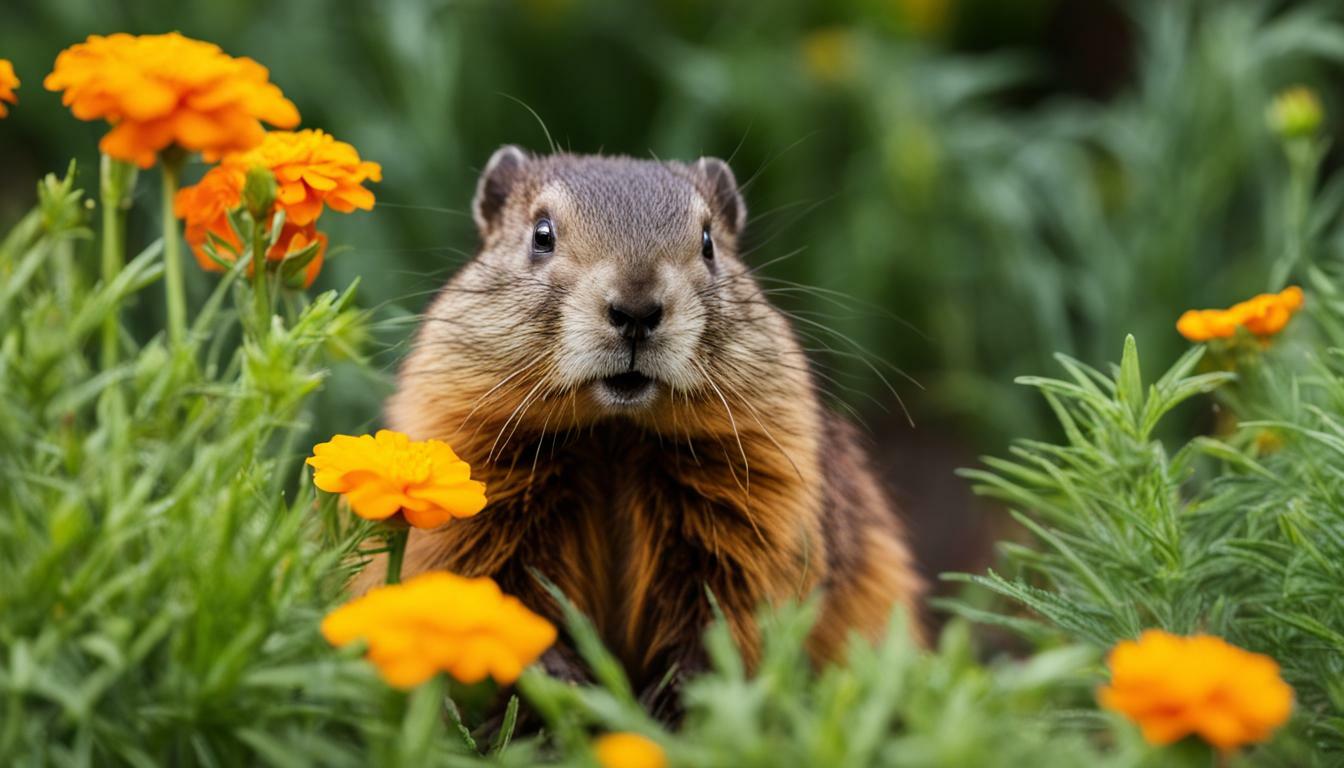Groundhogs are known for their appetite for plants, but do they eat marigolds? In this article, we will explore the relationship between groundhogs and these colorful flowers, as well as provide tips on how to protect your marigolds from these furry garden dwellers.
Key Takeaways:
- Groundhogs do eat marigolds, but they are not their favorite flowers.
- Groundhogs primarily consume plants and will eat a variety of flowers, including marigolds.
- Preventing groundhogs from eating your marigolds can be achieved through various methods, such as using natural scents, playing sounds of predators, sprinkling repellents, and fencing your garden.
- Other animals like rabbits, deer, squirrels, raccoons, mice, and skunks may also eat flowers in your yard.
- Consider using natural repellents and humane methods to deter groundhogs and protect your marigolds.
Groundhog Feeding Habits
Groundhogs have a varied diet and will eat a range of flowers, including marigolds, but they may have certain preferences. These garden-dwelling creatures are primarily herbivores, consuming a variety of plants to sustain themselves. While groundhogs may nibble on marigolds, they also show interest in other flowers such as daylilies, roses, zinnias, impatiens, and petunias.
It is important to note that groundhogs’ feeding habits can be influenced by the availability of other food sources. If there is an abundance of other plants or vegetation in the area, they may not focus their attention on marigolds or other flowers. This suggests that groundhogs view marigolds as just one potential option among many, rather than a preferred choice.
To protect your marigolds and other plants, there are several strategies you can employ. One approach is to use natural scents that groundhogs find unpleasant, such as coyote urine. Playing sounds of barking dogs and coyotes can also help deter these garden pests. Additionally, sprinkling repellents like cayenne pepper or strong essential oils can discourage groundhogs from feeding on your flowers.
| Groundhog Feeding Habits | Groundhog Behavior and Diet |
|---|---|
| Groundhogs have a varied diet, including flowers like marigolds. | Groundhogs primarily eat plants and will consume a variety of flowers, including marigolds, daylilies, roses, zinnias, impatiens, and petunias. |
| Groundhogs may have preferences for certain flowers based on availability. | However, they may not eat these flowers if other food sources are readily available. |
| Protecting marigolds from groundhogs can be achieved through various methods. | Methods include using natural scents like coyote urine, playing sounds of barking dogs and coyotes, sprinkling repellents like cayenne pepper or strong essential oils, and fencing the garden. |
| Other animals that may eat flowers in the yard include rabbits, deer, squirrels, raccoons, mice, and skunks. | Live traps can also be used to capture groundhogs and relocate them to another area. |
It’s worth mentioning that groundhogs are not the only animals that may devour flowers in your yard. Other culprits include rabbits, deer, squirrels, raccoons, mice, and skunks. If you’re experiencing flower damage, it’s important to consider these other potential pests as well.
In conclusion, while groundhogs may eat marigolds, they do not necessarily favor them over other flowers. By implementing effective deterrent methods and considering alternative flower choices, you can protect your marigolds from groundhog damage and maintain a flourishing garden.
Marigold Plant Safety
If you’re concerned about the safety of marigolds for groundhogs, read on to learn more about their potential effects. Groundhogs are known to eat a wide range of plants, including marigolds, but these flowers are not their favorite. Groundhogs primarily consume plants and flowers when other food sources are scarce.
Marigolds, with their vibrant colors and distinct scent, can add beauty to any garden. However, if you’re worried about groundhogs damaging your marigolds, there are steps you can take to protect them. One option is to use natural scents that deter groundhogs, such as coyote urine. By placing coyote urine around your garden, you can create an environment that groundhogs want to avoid.
Another method to protect your marigolds is to play sounds of barking dogs or coyotes in the garden. Groundhogs are cautious by nature and will be deterred by the presence of potential predators. Sprinkling repellents like cayenne pepper or strong essential oils can also discourage groundhogs from feasting on your flowers.
| Methods to protect marigolds from groundhogs: |
|---|
| Use natural scents like coyote urine |
| Play sounds of barking dogs or coyotes |
| Sprinkle repellents like cayenne pepper or strong essential oils |
| Fence the garden |
| Use live traps to capture and relocate groundhogs |
However, it’s important to note that marigolds are generally considered safe for consumption by groundhogs. While they may nibble on marigolds, groundhogs prefer other plants and flowers when available. If you’re concerned about groundhogs damaging your garden, consider planting alternative flowers that are less appealing to these critters.
Groundhogs as Garden Pests
Groundhogs can be a nuisance in gardens, causing damage to various plants, including marigolds. These furry creatures are herbivores and have voracious appetites, which can lead to destruction in your precious flower beds. While marigolds are not their favorite flowers, groundhogs have been known to munch on them, along with other popular blooms like daylilies, roses, zinnias, impatiens, and petunias. However, their preference for these flowers may vary depending on the availability of alternative food sources.
To protect your marigolds and other garden plants from groundhog damage, there are several strategies you can employ. One effective method is to use natural scents that deter groundhogs, such as coyote urine. The smell of a potential predator can make groundhogs think twice before venturing into your garden. Another tactic is to play recordings of barking dogs or coyotes, as the sound of these animals can frighten groundhogs away.
Additionally, you can sprinkle repellents around your garden to discourage groundhogs from feasting on your marigolds. Cayenne pepper or strong essential oils like mint or garlic are common repellents that can make your plants less enticing to these garden pests. Fencing is also a viable option, as it creates a physical barrier that prevents groundhogs from accessing your plants. Make sure the fence is buried at least a foot deep to prevent them from burrowing underneath.
| Recommended Methods for Groundhog Deterrence |
|---|
| Use natural scents like coyote urine to deter groundhogs |
| Play recordings of barking dogs or coyotes to scare away groundhogs |
| Sprinkle repellents such as cayenne pepper or strong essential oils around your garden |
| Install fencing that is buried at least a foot deep |
If all else fails, you can resort to live trapping. This involves setting up humane traps designed specifically for groundhogs and relocating them to a different area far from your garden. However, it’s important to check local regulations before attempting this method, as some jurisdictions may require permits or restrict the relocation of wildlife.
Remember, groundhogs are not the only animals that may feast on your flowers. Other critters like rabbits, deer, squirrels, raccoons, mice, and skunks can also present a threat to your garden. By implementing the aforementioned deterrents and considering alternative flower choices, you can minimize the risk of damage to your marigolds and other beautiful blooms.
Protecting Marigolds from Groundhogs
Keep your marigolds safe from groundhogs with these effective gardening tips. While groundhogs do eat marigolds, they are not their favorite flowers. These furry creatures primarily consume a variety of plants, including marigolds, daylilies, roses, zinnias, impatiens, and petunias. However, they may not target these flowers if there are other food sources readily available.
Fortunately, there are various methods you can employ to prevent groundhogs from feasting on your marigolds. One approach is to utilize natural scents that deter these critters. Consider using products like coyote urine, which groundhogs view as a predator signal, prompting them to stay away. Additionally, playing sounds of barking dogs or coyotes in your garden can also discourage groundhogs from approaching.
Another effective technique is sprinkling repellents around your marigolds. Groundhogs dislike strong scents, so using cayenne pepper or essential oils like peppermint, garlic, or castor oil can help keep them at bay. When applying these repellents, be sure to follow the instructions and reapply them regularly for maximum effectiveness.
| Tips for Protecting Marigolds from Groundhogs |
|---|
| Use natural scents like coyote urine |
| Play sounds of barking dogs or coyotes |
| Sprinkle repellents like cayenne pepper, peppermint oil, garlic oil, or castor oil |
| Install fencing around your garden |
| Use live traps to capture and relocate groundhogs |
Another option is to install fencing around your garden to keep groundhogs out. Ensure the fence is at least 3 feet high and extends at least 1 foot below ground level to prevent them from burrowing underneath. Make sure the fence is secure and does not have any gaps or openings that groundhogs could squeeze through.
If all else fails, you can also consider using live traps to capture groundhogs and relocate them to another area. Contact your local wildlife agency to inquire about the proper procedures for trapping and releasing these animals safely and legally.
It’s important to note that groundhogs are not the only animals that may pose a threat to your marigolds. Other flower-munching culprits include rabbits, deer, squirrels, raccoons, mice, and skunks. Keep an eye out for signs of these animals in your garden and take appropriate measures to protect your precious blooms.
Methods of Groundhog Deterrence
By understanding groundhog behavior and using proper deterrents, you can protect your marigolds from these garden intruders. Groundhogs are herbivores and will consume a variety of flowers, including marigolds, but they may not eat them if other food sources are readily available. To keep groundhogs away from your precious marigolds, here are some effective methods of deterrence:
- Natural Scents: Groundhogs have a keen sense of smell, so using natural scents can help repel them. Consider using coyote urine, which mimics the presence of a predator, or sprinkle strong-smelling essential oils like peppermint, garlic, or castor oil around your garden.
- Sound Repellents: Groundhogs are wary of sounds that indicate danger. Install motion-activated devices that play recordings of barking dogs or coyotes. The sudden noise will startle groundhogs and make them think twice before venturing into your garden.
- Repellent Sprays: Groundhogs dislike certain tastes, so spraying your marigolds with a mixture of cayenne pepper, garlic, or hot sauce can deter them from nibbling on the flowers. Be sure to reapply after rainfall.
- Fencing: Physical barriers are an effective way to keep groundhogs out of your garden. Install a sturdy fence around your flower beds, making sure it extends at least 2 to 3 feet underground to prevent burrowing.
- Live Traps: If all else fails and groundhogs persist in invading your garden, using live traps can help you capture and relocate them to a more suitable area. Release them far away from your property to avoid their return.
Remember to keep your garden clean and remove any potential food sources, such as fallen fruits or vegetables, that may attract groundhogs. By implementing these methods of deterrence, you can safeguard your marigolds and enjoy their vibrant blooms throughout the gardening season.
| Deterrent Method | Effectiveness |
|---|---|
| Natural Scents | High |
| Sound Repellents | Medium |
| Repellent Sprays | Medium |
| Fencing | High |
| Live Traps | Medium |
Alternative Flower Choices for Groundhogs
If you’re concerned about groundhogs eating your marigolds, consider planting other flowers that may be less appealing to them. While groundhogs do consume a variety of flowers, including marigolds, there are alternative options that they are less likely to feast on. By incorporating these flowers into your garden, you can help protect your marigolds and maintain a beautiful outdoor space.
Here are some flower choices that groundhogs tend to avoid:
- Daffodils: These vibrant flowers are not typically on a groundhog’s menu. They possess a strong scent and taste that groundhogs find unappealing.
- Tulips: Groundhogs are generally not attracted to tulips. These colorful blooms can add elegance to your garden while deterring these furry critters.
- Lavender: The strong aroma of lavender repels groundhogs and other unwanted garden visitors. Planting this fragrant herb can help keep them at bay.
- Alliums: Alliums, such as onions, garlic, and chives, have a strong scent that groundhogs typically dislike. Adding these plants to your garden can help protect your marigolds.
By incorporating these alternative flowers into your garden, you can create a beautiful and groundhog-resistant environment. Remember, though, while these flowers are less appealing to groundhogs, they may still be enjoyed by other animals such as rabbits, deer, and squirrels. Implementing additional protective measures, like fencing and natural repellents, can help safeguard your garden from various flower-eating visitors.
| Flower | Eating Habit |
|---|---|
| Daffodils | Not typically consumed |
| Tulips | Generally avoided |
| Lavender | Repels groundhogs |
| Alliums | Unappealing to groundhogs |
Other Animals That May Eat Flowers
Groundhogs aren’t the only animals that may have a taste for flowers like marigolds. In fact, there are several other critters that can find these colorful blooms quite tempting. Here are some common garden visitors that might have a nibble on your precious flowers:
- Rabbits: These furry pests can quickly devour your marigolds, as well as other plants in your garden.
- Deer: If you live in an area with deer populations, you may find that these majestic creatures have a fondness for marigolds.
- Squirrels: While squirrels are more notorious for stealing birdseed, they can also snack on flower petals.
- Raccoons: These clever creatures have been known to raid gardens, including flower beds, in search of food.
- Mice: Although small, mice can still cause damage by nibbling on delicate flowers, including marigolds.
- Skunks: Skunks are omnivorous and may munch on flowers, especially if they can’t find their preferred food sources.
It’s essential to address the presence of these animals in your garden to protect your beloved marigolds and other flowers. Implementing preventive measures and natural deterrents can help minimize the damage they may cause.
Prevention and Deterrence Methods
To safeguard your marigolds and keep unwanted visitors away, consider these effective methods:
- Natural Scents: Animals like groundhogs, rabbits, and deer are deterred by the smell of predators. Using natural scents such as coyote urine or predator scents can help keep them away from your flowers.
- Sound Repellents: Playing sounds that mimic the barking of dogs or the howling of coyotes can create the illusion of a predator presence, discouraging animals from approaching your garden.
- Repellent Sprays: Sprinkling substances like cayenne pepper or strong essential oils, such as peppermint or eucalyptus, around your flowers can make them less appealing to animals.
- Fencing: Installing a sturdy fence around your garden can be an effective physical barrier to keep animals out. Make sure the fence has buried mesh to prevent digging.
- Live Traps: If you prefer a humane approach, you can use live traps to capture groundhogs and other pests. Once trapped, you can relocate them to a more suitable habitat away from your garden.
By employing these preventive measures and deterrents, you can protect your marigolds and enjoy their vibrant blooms all season long.
| Animal | Common Diet |
|---|---|
| Rabbits | Vegetation, including flowers |
| Deer | Plants, including flowers |
| Squirrels | Nuts, seeds, and sometimes flowers |
| Raccoons | Various foods, including fruits and flowers |
| Mice | Seeds, fruits, and flowers |
| Skunks | Insects, fruits, plants, and flowers |
Natural Repellents for Groundhogs
Discover natural and effective ways to keep groundhogs away from your marigolds with these repellent options. Groundhogs, also known as woodchucks, can be a nuisance in your garden as they have a voracious appetite for plants, including marigolds. By using natural repellents, you can discourage these furry intruders from snacking on your precious flowers.
One option is to utilize scents that groundhogs find unpleasant. Coyote urine is a powerful deterrent as it mimics the presence of a predator in the area. Simply sprinkle a few drops of coyote urine around your marigolds to create an invisible barrier that keeps groundhogs at bay. Another effective scent-based repellent is the smell of barking dogs and coyotes. You can purchase sound devices that emit these noises periodically, tricking groundhogs into believing there is a threat nearby.
When it comes to physical repellents, cayenne pepper is a popular choice. Groundhogs dislike the spicy nature of cayenne pepper, so sprinkle it generously around your marigolds. Alternatively, you can make a solution by mixing water and hot sauce, and then spray it on the plants. Strong essential oils, such as peppermint or garlic, can also be used as a deterrent. Dilute a few drops of the oil in water and spray it on and around your marigolds to keep groundhogs away.
Table: Natural Repellents for Groundhogs
| Repellent | Description |
|---|---|
| Coyote urine | Mimics the presence of a predator |
| Barking dog and coyote sounds | Creates the illusion of a threat |
| Cayenne pepper | Spicy deterrent |
| Peppermint or garlic essential oil | Strong scents that groundhogs dislike |
In addition to these repellents, fencing can provide an effective physical barrier to protect your marigolds. Use wire mesh or chicken wire to create a fence around your garden, ensuring that it is buried at least a foot deep to prevent groundhogs from burrowing under it. Live traps can also be employed to catch groundhogs and relocate them to another area where they won’t cause damage.
Remember, groundhogs are not the only animals that may munch on your flowers. Other common culprits include rabbits, deer, squirrels, raccoons, mice, and skunks. Consider using similar repellent methods to keep these animals away from your garden as well.
Conclusion
Groundhogs may eat marigolds, but with the right precautions, you can protect your beloved flowers from these garden visitors. While groundhogs are known to consume a variety of flowers, including marigolds, they typically prefer other plants in their diet. Daylilies, roses, zinnias, impatiens, and petunias are also on their menu.
However, there are several effective methods to deter groundhogs from feasting on your marigolds. One option is to use natural scents that mimic predators, such as coyote urine. You can sprinkle these scents around your garden to discourage groundhogs from approaching. Another tactic is to play sounds of barking dogs and coyotes, as this can create a hostile environment that groundhogs will want to avoid.
In addition to deterrents, you can also try sprinkling repellents like cayenne pepper or strong essential oils around your marigolds. These scents can be unpleasant to groundhogs and may deter them from nibbling on your flowers. Alternatively, fencing your garden can be an effective way to physically keep groundhogs out and protect your marigolds from their hungry appetites.
Remember, groundhogs are not the only culprits when it comes to flower feasting. Other animals such as rabbits, deer, squirrels, raccoons, mice, and skunks may also enjoy snacking on the blossoms in your yard. By taking the necessary precautions and utilizing these methods, you can create a garden sanctuary that keeps your marigolds and other flowers safe from all unwanted visitors.
FAQ
Do groundhogs eat marigolds?
Groundhogs do eat marigolds, along with a variety of other flowers such as daylilies, roses, zinnias, impatiens, and petunias. However, marigolds are not their favorite flowers.
What are groundhog feeding habits like?
Groundhogs primarily eat plants and will consume a variety of flowers. Their diet also includes grasses, clover, dandelions, fruits, vegetables, and tree bark.
Are marigolds safe for groundhogs to consume?
Marigolds are generally safe for groundhogs to eat. However, they may not eat these flowers if other food sources are readily available.
How can groundhogs be detrimental to gardens?
Groundhogs can dig burrows in gardens, damage plant roots, and consume flowers and plants, including marigolds.
How can I protect my marigolds from groundhogs?
To protect marigolds from groundhog damage, you can use methods like using natural scents like coyote urine, playing sounds of barking dogs and coyotes, sprinkling repellents like cayenne pepper or strong essential oils, fencing the garden, or using live traps to capture and relocate groundhogs.
What are some alternative flower choices for groundhogs?
If you want to plant flowers that groundhogs are less likely to eat, consider options such as daffodils, foxgloves, lavender, mint, or snapdragons.
What other animals may eat flowers in the yard?
Other animals that may eat flowers in the yard include rabbits, deer, squirrels, raccoons, mice, and skunks.
What natural repellents can I use to deter groundhogs?
Some natural repellents to deter groundhogs include coyote urine, barking dog or coyote sounds, sprinkling cayenne pepper or strong essential oils, or using other strong scents.
Do groundhogs have any specific gardening tips?
Groundhogs are persistent and adaptable creatures. Using a combination of deterrent methods and maintaining a clean and well-maintained garden can help minimize damage to marigolds and other plants.
How does the article conclude the relationship between groundhogs and marigolds?
The article concludes by summarizing the information covered, emphasizing that while groundhogs do eat marigolds, these flowers are not their favorite. It also highlights the various methods and strategies for protecting marigolds and other plants from groundhog damage.




